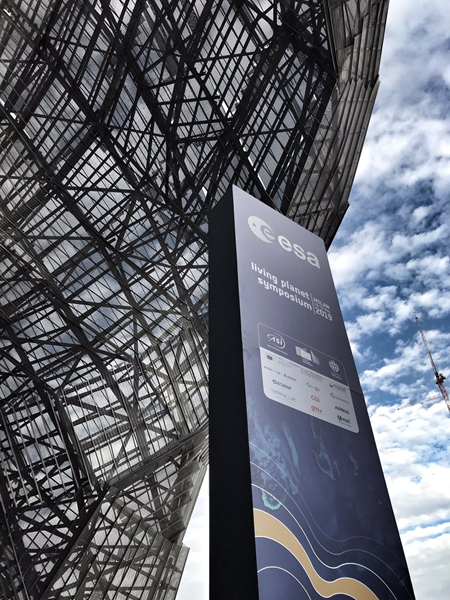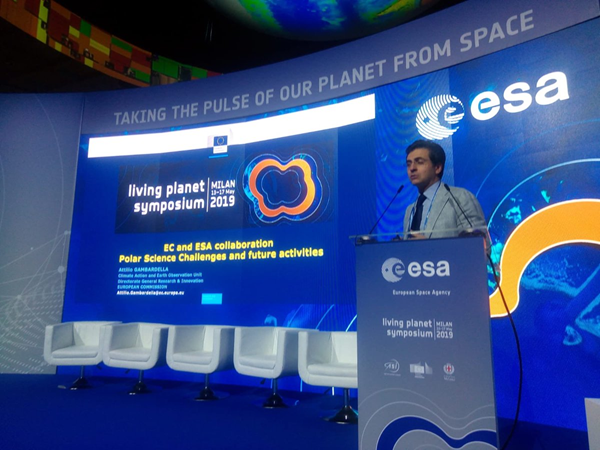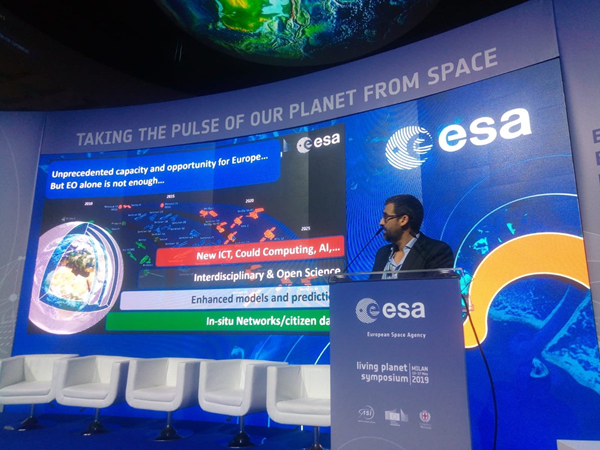
Pedro Gonçalves, Terradue, presenting INTAROS at the ESA Living Planet Symposium.
Attracting thousands of scientists and data users, ESA’s Living Planet Symposia are among the biggest Earth observation conferences in the world. This year’s symposium was held in Milan, Italy, on 13–17 May 2019. The Living Planet Symposium 2019 was bigger and wider ranging than ever before with participants not only presenting their latest findings on Earth’s environment and climate derived from satellite data, but also focusing on Earth observation role in building a sustainable future and a resilient society.

During the Symposium, the Directorate General for Research and Innovation (DG RTD) of the European Commission and the European Space Agency (ESA) organized a special event presenting existent framework agreement to coordinate, align and cluster research activities funded under Horizon 2020 and the ESA Earth observation scientific programme focusing on Polar science.

The objectives of the event were to update the scientific community about the cooperation, to describe what DG RTD and ESA already fund to support Polar science, to inform about their future common plans, and to receive feedback on how to further develop the cooperation and support clustering activities.
In addition there were presentations from ESA and H2020 funded projects. From the ESA-funded projects, the British Antarctic Survey presented the PolarTep project, the Geological Survey of Denmark and Greenland presented the S34Sci Snow Albedo project, and the University of Edinburgh presented the CryTop project. The H2020 projects were represented by the Alfred-Wegener-Institut presenting the EU-PolarNet, B. GEOS GMBH presenting the project NUNATARYUK and Terradue presenting the INTAROS project.

In his presentation of INTAROS, Pedro Gonçalves focused on how the long-term Arctic monitoring rests on a combination of satellite information and in situ observations and is currently the most advanced EU-initiative for Community Based Monitoring (CBM) in the Arctic, joining local & scientific knowledge.

The role of the INTAROS iAOS (integrated Arctic Observing System, joining the diverse observing systems for atmosphere, ocean, cryosphere, terrestrial sciences and local communities) is defined on three main axis: integrate, deploy and manage. The integration of existing observing systems connects observations and derived parameters with EO services and tools for data analysis, transformation & visualization. The deployment of new processing services as scalable Cloud services, is leveraging data and computing resources made available by the European Open Science Cloud and by the Copernicus Data and Information Access Services (DIAS). Such deployments will support the management of processing campaigns for existing and new observations, with advanced geostatistics and visualization toolkits.
Concluding the presentation the recommendations of the INTAROS Project community for the Polar science future plans, in the scope of the EC-ESA partnership initiative, focused on the following points:
● Enlarge the coordination and collaboration between data providers and stakeholders in the pan-Arctic region
● Reshape observing platforms from research to operational systems, filling gaps in observations
● Improve data sampling, transmission, calibration, processing, archiving and retrieval of required variables
● Survey key resources for sustainability and targeting new sponsorship opportunities, e.g. H2020 Open Clouds for Research Environments (OCRE), ESA Network of Resources (NoR).
12 June 2019